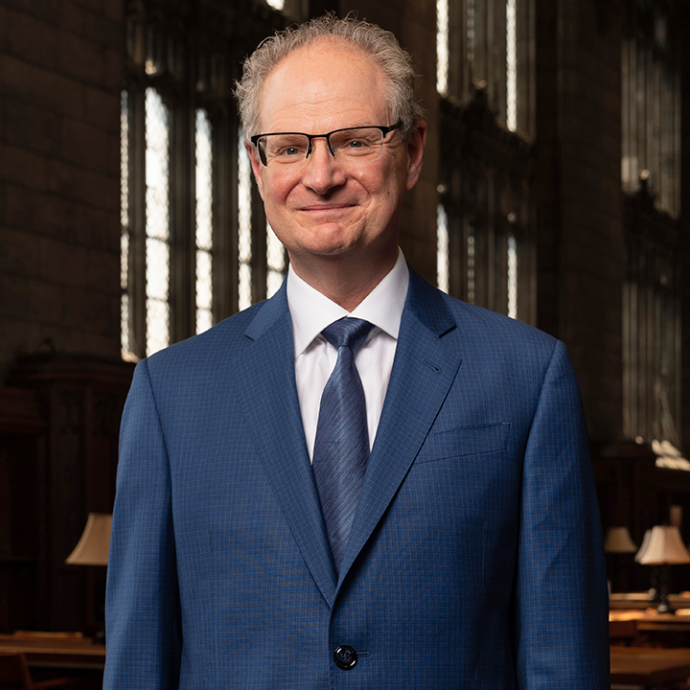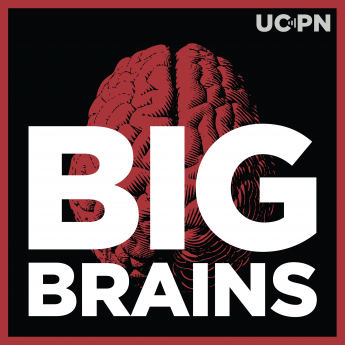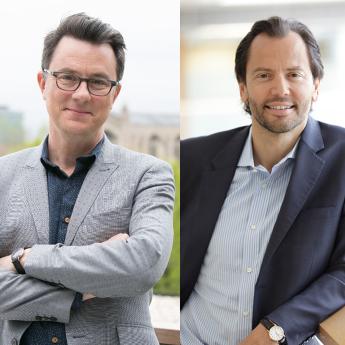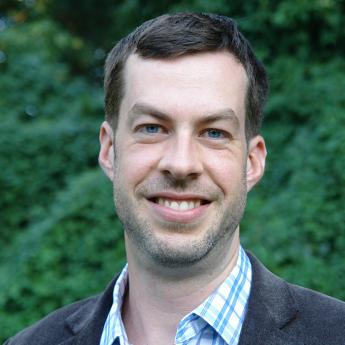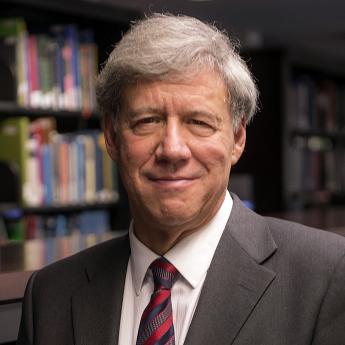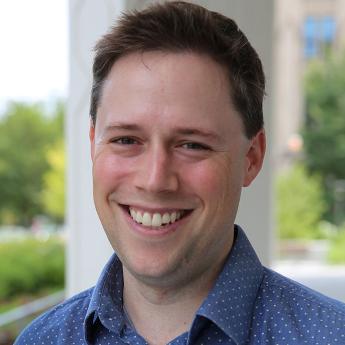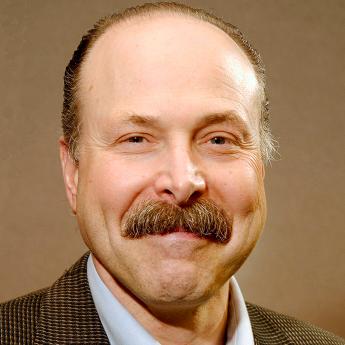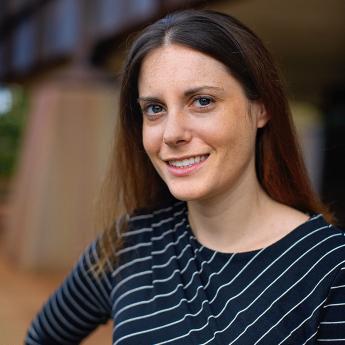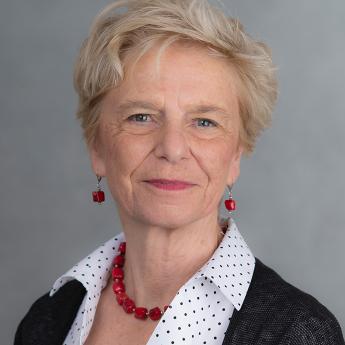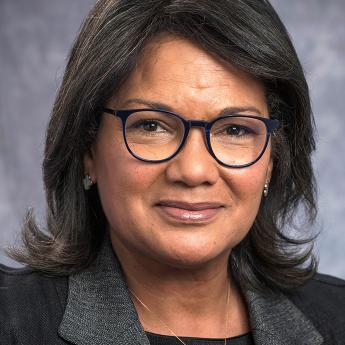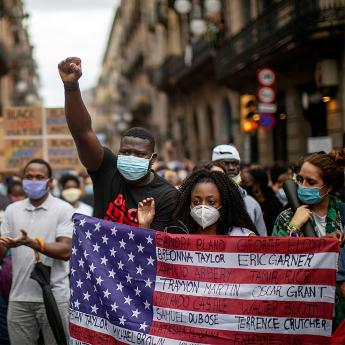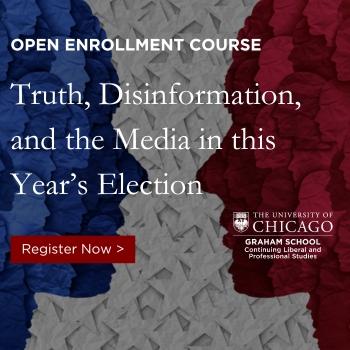Show Notes
Sometimes, the biggest discoveries have to do with the smallest things. In this case, we’re talking about breakthroughs at the nanoscale—specifically, nanocrystals. Paul Alivisatos has been a pioneering figure in the field of nanoscience, but he’s also found ways to use these tiny crystals to create incredible new technologies for use in health care, energy and electronic devices.
In addition to being a world-renowned chemist, Alivisatos is an accomplished leader in higher education who recently began his tenure as president of the University of Chicago. In that role, he hopes to implement his vision of an “engaged university” to advance the role of academia in society.
Subscribe to Big Brains on Apple Podcasts, Stitcher and Spotify.
(Episode published September 23, 2021)
Related:
- Incoming UChicago President Paul Alivisatos accepts Priestley Medal—UChicago News
- Priestley Medal address 2021: The growth of the nanocrystal—a little coming-of-age story—Chemical & Engineering News
- The Frontiers of Knowledge Award goes to Paul Alivisatos and Michael Grätzel for developing new nanomaterials with applications in solar energy and cutting-edge electronics—Frontiers of Knowledge Award
- Prof. Paul Alivisatos, 2016 Dan David Prize Laureate—YouTube
- Berkeley Lab Director Paul Alivisatos Wins Wolf Prize in Chemistry—Berkeley Lab
Transcript:
Paul Rand: Sometimes the biggest discoveries have to do with the smallest things.
Paul Alivisatos: So a nanocrystal is a crystal whose dimensions could be measured in nanometers, a billionth of an inch or a billionth of a meter.
Paul Rand: In this case, we’re not just talking small, or really small, or really, really small. We’re talking nano, about as small as you can get and still retain a structure.
Paul Alivisatos: They’re literally crystals. The atoms are all arranged in a periodic way inside them, just like they are in a crystal...
Paul Rand: This is Paul Alivisatos. He’s a world-renowned chemist who recently won the Priestley Award, one of the highest awards in chemistry, for his nanocrystal discoveries and their applications.
Paul Alivisatos: And it is bestowed to an individual who has both contributed in the world of scholarship, but has also contributed to making the scientific community stronger in substantial ways.
Paul Rand: Alivisatos’ research may happen at a micro scale, but he’s also contributed to academia in some pretty big ways. He served as the executive vice chancellor and provost at the University of California, Berkeley, and recently took office as the new president of the University of Chicago.
Paul Alivisatos: I’m also really looking forward to the new things that are happening at the University, and how all the ways in which it is finding to reach out and touch the practical world and to feel like to become a more engaged University of Chicago.
Paul Rand: It may seem like Alivisatos leads two different lives—the scholar and the university leader—but there’s an underlying philosophy that pulls them both together. One that he says he hopes to bring to Chicago.
Paul Alivisatos: Universities are becoming much more connected to society and to the regions that they belong and, if you like, they’re becoming more porous. The university and the region around it—the city—are interconnecting more and more.
Paul Rand: From the University of Chicago Podcast Network, this is Big Brains, a podcast about the pioneering research and pivotal breakthroughs that are reshaping our world. On this episode, using research on the tiniest and the largest scales to change the world.
Paul Rand: Nanocrystals sound like a futuristic technology, and in many ways they are, but there’s a good chance you interact with them every day and may not even know it. But before we can get into how they’re used, we actually need to understand what they are.
Paul Alivisatos: To make it a little bit simpler, we could say that they might have anywhere from, let’s say 100 to 100,000 or so, atoms in them.
Paul Rand: Just to get an idea of the scale we’re talking about here, an average grain of sand has more than a trillion atoms.
Paul Alivisatos: The atoms are all arranged in a periodic way inside them, just like they are in a crystal. They would look a little bit funny if you could actually see one with your eye. They’re small because in order to prevent them from aggregating—two of them just colliding and hitting and then sticking with each other and becoming a great big thing—we will typically coat them with some "hair," if you like: some molecules that stick out and are a little bit frizzy and prevent them from colliding with each other. So they’d kind of look like a very ordered crystal on the inside, and then frizzy hair sticking out of them on the outside.
Paul Rand: Okay. Now, you’ve mentioned in the past about them being so interesting because of the scaling laws that define them, and I wonder if you can explain what scaling laws are?
Paul Alivisatos: Well, let me give you a feeling for it. Many of your listeners may have heard of the idea that Democritus himself, the Greek philosopher, thought of how to imagine the possibility of atoms, and the way he thought about it was... Let’s say a piece of gold and it’s got some properties. And then you imagine a successive division. So you take that piece of gold, you chop it into two pieces, and if you measured its density or you measured its hardness, they’d be the same. It would just be a smaller piece, but if you keep chopping it in two again and again, at least in Democritus’ mental experiment, if you keep chopping it in two, eventually it would become so small that he imagined that it would be indivisible. Which is what the word ‘‘atom’’ means, in fact—indivisible.
And what’s so interesting is if you think about crystals as you chop them in two, but they get to be really small. Let’s say there are 1,000 atoms, and then 500 and then 250. It turns out that as they get that small, every time you cut them in two, they actually show a different density, a different melting temperature, a different... Any property almost that you choose will not be the same, as it heads towards becoming an atom in that very large number of divisions.
Paul Rand: Basically, our known laws about how a certain material should behave change at the nanoscale. We have to throw our assumptions out the window.
Paul Alivisatos: What it means is essentially we can almost look at a periodic table, at an element if it’s a solid element, and say, ‘‘There’s really a third dimension to this table, which has to do with how big the atoms are, how big the crystals are.’’ And, that’s a very rich topic that has, it turns out, lots of consequences for how we make materials and what kind of properties they have.
Paul Rand: One of those laws governs a crystal’s melting point.
Paul Alivisatos: Let’s think of a crystal as... Imagine a playground of children that are all holding hands and they make a square, and they’re kind of jiggling around because they have a lot of energy, they’re kids. As it gets to be really big, everybody kind of gets locked in, but when it’s tiny, it’s easier to imagine some of them kind of peeling off. It’s a little bit like that. When you get to very, very tiny crystals, all the atoms on the surface are not attached as strongly because they don’t have neighbors on the other side. And it turns out as you make it very, very tiny, that crystal becomes much easier to melt than a large one. And that turns out to be really important because it means that you can heat and cool them at much lower temperatures in terms of being fluid than you might have otherwise, and that’s very practically useful.
Paul Rand: The scale also affects the quality of the crystals you can make. In fact, it allows you to make a crystal with zero flaws; a perfectionist’s dream.
Paul Alivisatos: Yeah, that’s right. To use another analogy there... Imagine going to the jewelry store and you’re going to buy a diamond ring for somebody you love. You’ve got a certain amount of money. And so you say to the jeweler, ‘‘I want to buy a diamond.’’ They show you one and it’s beautiful. And then you say, ‘‘Well, look, why can’t I buy one that’s twice as big?’’ And they say, ‘‘Well, you could, of course, but it’ll cost you four times as much.’’ Well, why will it cost more? Because to have a diamond with no defects, the bigger it is, the less likely that is. Think about turning that upside down now. And you’re saying, ‘‘Well, the smaller I make the crystal, how likely is it to have a defect?’’ Well, less and less likely, actually, just by the same logic. So if I have a really tiny crystal, and if I can just warm it up a little bit, it’ll push all the defects out.
And only one out of every absolutely astronomical number of crystals might have any defect in it. So in fact, when you make crystals very, very tiny, that works in your favor in that you’re able to make them essentially all really as close to perfect as we can make any materials, almost. You can do that with very modest processing because the temperatures of melting are so low. It turns out that that really means that we can get high-performing materials with very simple processing. With not so much effort, we can make materials that really are darn near perfect.
Paul Rand: That matters because a lot of technology works better if you have perfect crystals going into it. When you’re an engineer, for example, trying to make a good TV, you want perfect crystals. Moreover, you want to be able to make the exact size and shape nanocrystals that you need.
Paul Alivisatos: All the properties depend on size. So if we want to really be able to adjust the material to have a very specific property, we have to be able to pick its size very precisely. And so if we make some smaller ones and some larger ones, we’ll just have a mishmash of many different properties because the properties depend so much on size.
Paul Rand: Alivisatos’ foundational nanocrystal discoveries are impressive on their own, but just making discoveries wasn’t enough for him.
Paul Alivisatos: Once those materials had been made, the question was, ‘‘So what?’’ You can see these effects. They’re interesting and so on. That’s great, but it was also a question of, ‘‘Could these turn out to actually have some kind of use?’’
Paul Rand: As it turns out, they not only have a use, but many uses. A lot of us use these tiny crystals every day, without even knowing it in televisions.
Paul Alivisatos: An example of that would be the color.
Paul Rand: Right. Have you noticed the color quality on your TV screens getting dramatically better? Well, that’s all because of Alivisatos’ nanocrystals, especially what happens when you turn them into semi-conductors.
Paul Alivisatos: Well, in a semiconductor material, all the bonds are formed by electrons that are kind of shared between atoms. And the electrons aren’t really moving around too much, unless you put in a lot of extra energy, and then the electron will start to zoom around the crystal and maybe fall back down and relax. So that’s a semiconductor material. It’s a material which is normally not conducted, but if you put some extra energy into it, it can become conductive. And when you have a tiny semiconductor, it does something very special.
So if you’ve been to a science museum, you probably at some point saw one of those funnel-shaped objects you can throw a ball into and as the ball goes around, and as it goes down lower and lower into the funnel, it moves faster and faster, right? Okay. So now imagine you have a very tiny semiconductor crystal and you dislodged one of those electrons that’s bonded between all the atoms. And now it starts moving around and it turns out, the smaller the crystal, that electron will start to zing around inside there and move really fast. And the smaller it is, the faster it moves. It turns out that that means that when the electron relaxes back down and releases energy by emitting light, the smaller the crystal, the higher the energy of that light will be, or the bluer the wavelength.
Paul Rand: When you do this to a nanocrystal, it becomes what’s called a quantum dot.
Paul Alivisatos: So if you have a so-called quantum dot and you make it different sizes because of the fact that it will push on that electron and make it move, it will emit different colors of light. And you can tune those very precisely to be a very specific wavelength because the crystals can all be made pretty much exactly the same size. Those colors will be very pure, and that’s all called the quantum size effect.
Because you can tune the colors so precisely, you can match the three receptors in our eyes. We have red, green, and blue receptors to infer all the other colors. Our brain actually processes color by looking at the ratio of reds, greens and blues. And because the quantum dots have very precise colors, a very precise green, a very precise red, and a precise blue, you can recreate all the other colors. The full gamut of colors are there much more faithfully than you could otherwise.
And that’s getting better and better. Within a few generations of quantum dot TV, I think it will be the case that every color that our eye can see, and more, will be represented by the quantum dot TV. Today, it’s pretty close to that, and it’s certainly much better than the kinds of displays that we had available five to 10 years ago.
Paul Rand: But the uses for these quantum dots go way beyond just making your Netflix shows look sharper.
Paul Alivisatos: Yeah, well, because these tiny crystals are so small, they’re about the size of a protein, it turns out they can be readily introduced inside a biological specimen and they can emit light there.
As an example, if somebody has to have a biopsy, it’s very likely that the pathologist will want to stain the tissue with a particular species to indicate whether it’s a benign, for example, or malignant tumor. There are ways to work out the biological recognition part, but to have it attached to one of these tiny crystals, and if it binds, then you can see a certain color. It’s very likely that if you have a biopsy that the pathologist will use quantum dots, for example, in order to read out what’s happening, or other biological researchers will use them for a variety of reasons. They’ll make the decision to use these as a kind of biological luminescent probe to tell signals about what’s happening in the biological system. So they’re widely used for that, and they’re commercially available, and that’s a whole area.
Paul Rand: From a tiny discovery to helping save lives, Alivisatos’ work is a perfect example of what’s possible when scholars pair foundational research with an eye toward solving problems. Quantum dots hold even more promise for climate change, such as windows or walls infused with dots that could absorb light energy to power a home, but nothing’s concrete yet.
Paul Alivisatos: I really have wanted for some years now to see the materials that we know how to make, and that have these wonderful properties, turn out to really have a good impact in the energy space.
Paul Rand: One of Alivisatos’ core missions with his work is to find ways to instrumentalize foundational discoveries outside the lab. That perspective can create a useful feedback loop for researchers that carries back into the laboratory.
Paul Alivisatos: For example, we made, or I made, some missteps along the way. At one point, I thought we could make solar cells. They may not be as high-performance as the best solar cells, but they would be very low-cost. That turned out to be a blind alley because when the manufacturing scale of Silicon became very large, the cost just dropped immediately. It went from $10 a watt to well below $1 a watt in a very short period of time, and that kind of wiped out a research direction that I had fallen in love with.
It was a really good example for me of showing how what happens in the practical world can provide a certain kind of discipline because my thinking was a little bit sloppy. I thought, ‘‘Well, if we can do it a low cost, that will be good enough.’’ But it turns out no, you really have to provide a material—if it’s going to be really valuable—that does something qualitatively different than people have ever seen before, not something that’s just incrementally better or just simply lower costs.
And so, I learned a lot from that lesson, and it’s another example of how it forced me to go back into my world of science and think a little bit more deeply about, ‘‘Hey, well, what could really be meaningful here?’’ And it’s prompted us to go in a new direction in my research; one I’m hoping to continue in laboratories in Chicago is to try to make some very funny kinds of new engines that operate with light instead of with fuel...
Paul Rand: Wow! OK.
Paul Alivisatos: And we’ll see.
Paul Rand: You may be hearing a theme emerging here. The idea of connecting what we do in the lab to what happens in the world is central to Alivisatos’ mentality.
Paul Alivisatos: And for me, that journey of going from the laboratory into seeing these things having a use actually played a really interesting role in when I made decisions about what to do next in my laboratory as a scholar, not just in my work trying to find an application. So I found that there was a kind of synergy between the discovery aspects and the applications.
Paul Rand: And that concept of thinking about it, because it’s the ability to think through some ideas and not only from the research side, but to think about having to be engaged or how to have an impact, or how to commercialize is its own different way of thinking and operating too, isn’t it?
Paul Alivisatos: It is. For example, when we had first shown biological labeling with quantum dots, we thought, ‘‘Okay, this can be commercialized.’’ I got involved in a company at that time on dot incorporation. And within about a year, the company had a much larger group than any academic group, because there was a real larger scale investment. They were trying to scale things up...
And so on and before you knew it, they were able to do things in the company that the universities had yet to even begin to think about doing. They’re way out ahead. And when I saw that as a scientist, of course I was helping them and trying to think with them, but I wasn’t on their team, I was helping. Then I would come back to the university and talk with my students. I didn’t really want to have people working on projects which I knew 10 miles away, people were way past it.
So at one point, we sat down and I said, ‘‘Hey, you know, group, we can keep going on this. Maybe publish a few more papers and stuff, but it’s time for us to try some different things.’’ And we started some new research directions, and we did that maybe two or three years earlier than some other people, because I knew that these things were coming and it was going to change. And so for me, that’s a very vivid example of what prompted me to go into certain other areas of nanoscience that I wouldn’t have done otherwise.
So in my particular case, the discovery, the placing it into commercial use, prompted me to turn back into a new period of discovery earlier than I might have otherwise. And that was really good for me. And I wouldn’t have done it if I hadn’t had that involvement.
Paul Rand: After the break, how Alivisatos wants to bring this approach to the University of Chicago to create his vision of what he calls ‘‘the engaged university.’’
Paul Rand: Thank you for listening to Big Brains. If you’re enjoying our podcast, please take a minute to give us a review and a rating, and tell a friend about the show too. We hope to share these conversations about pioneering research with as many people as possible. Again, thanks for listening.
Paul Rand: A defining feature of Alivisatos’ research career is his commitment to finding ways to get his discoveries to engage with the wider world. It made him the scholar he is today, and he wants to bring that same mentality to his new role as president of the University of Chicago with a vision he calls ‘‘the engaged university.’’
Paul Alivisatos: To me, it means that it’s a university community where we really do care about new knowledge and how it is created, but we also always have our eye on how that new knowledge can be of benefit to humanity and to our society.
Paul Rand: How do you make that happen?
Paul Alivisatos: We should contemplate the possibility of a handful of what I will call the vectors of engagement, or directions that we as a community believe are ones where there’s a combination of the greatest potential for really new foundational discovery that also can have an impact on our society and our communities. And so in the fall, as I begin I would really like to have a dialogue with the university community about what such vectors might look like. If we did have a handful of them, how could we structure them? Would they make sense to our university community?
Paul Rand: And does this, as you think about it, change what is expected or what it means to be a scholar?
Paul Alivisatos: Well, look, I think that people will do the beautiful scholarship that speaks to them. And there will be differences amongst scholars about how they approach this. Some may actually really just hone in and look at very foundational deep things that are not connected to immediate societal benefit. What I’m pointing out is that there are many, many examples around the university where this kind of engagement with the world of practice actually comes back and reinforces the work of foundational scholarship. I also think at the University of Chicago, our deep commitment to free expression is foundational—very important. And it’s part of what makes the University so strong because we can talk about or debate anything. That’s almost the bedrock of being able to have the ability to find out where will reason take us. And if we’re not able to have that discussion in the most open way, then we won’t be able to find the directions that reason takes us.
Paul Rand: Universities are certainly in a position to help apply science and technology to help us solve some of the world’s most pressing problems. But Alivisatos believes for universities to live up to this challenge, they need to invest beyond just the sciences.
Paul Alivisatos: Well, it’s interesting that you should say that we should science our way out of our problems. I guess my view of that is that science will help us with certain aspects of it, but there are other challenges that we have which require additional ways of thinking and new ways of framing and understanding our questions, or even revisiting the deepest ones. It’s wonderful coming back to the university to see how the arts have been blossoming across the university in so many different ways. And of course that is a deep way in which both we discover new things about ourselves. So the arts in a sense embody this example of discovery and engagement almost naturally, but yes, I do believe it’s very much there today in the humanities. Our society is today struggling with so many profound issues, which are the ones that are the subject of our deepest philosophy and all of our forms of humanistic inquiry.
It’s around us everywhere. We have, for example, the massive changes in media. How digital technologies are changing how we interact with each other. Those are deep questions that involve the humanities and social sciences. And I think our world needs, more than ever, the kind of really principled and deep thinking, humanistic thinking, and social science thinking that this university can bring to it.
To give an example, we are in a period where issues of climate, energy, and environment are really at the forefront of our minds. It was so striking to me... All of the students that I’ve met with in the recent period of time, almost every single one, this is the first thing that they brought up with me is they want to see the University of Chicago doing even more around issues of climate, energy, environment. It would be a mistake for us to think of that as only a technical problem. Surely our approach to this should involve what actually makes markets work, but there are also obviously policy dimensions, ethics dimensions... It really covers the gamut of all forms of human knowledge, in a sense. And so I hope an engaged University of Chicago will be at the forefront of thinking about these issues of climate and energy, and not just thinking about them, but helping our society through what looks like it will be one of our most difficult crises.
Paul Rand: One way Alivisatos those things thinks universities do need to change is to look in their own backyards more often. A good example is climate change. How should universities take the particulars of their region into account when studying and discussing this problem?
Paul Alivisatos: Well, the Chicago area and the region around it will, in fact, be experiencing the aspects of climate change in significant ways; issues related to the rise of Lake Michigan. After all, that’s the origin at some level of why Chicago is the metropolis it is; the handling and management of water at that very particular geographically critical point in the entire continent, but also the regional economy.
Paul Rand: Right.
Paul Alivisatos: What will be happening with regards to crops in the entire Midwest region. What will be happening when we have excursions of temperature to be...
Paul Rand: Absolutely.
Paul Alivisatos: Very, very hot. We will be having, unfortunately, many days that are extremely hot in a big city. And so, I hope an engaged University of Chicago will be at the forefront of thinking about these issues of climate and energy and not just thinking them, but helping our society through what looks like it will be one of our most difficult crises.
Paul Rand: Alivisatos has given himself a powerful mandate to lead UChicago into the future, but he’s not giving up on his research. He plans to bring his nanocrystals lab with him, which he believes will keep him even more connected to the university community.
Paul Alivisatos: Well, I really do, as you say, have a great deal of passion and love for the work that we do in the laboratory. And actually I have some evidence that this will be true in Chicago, too. At least when I was in the provost role, talking to students—not just in my research group, but others—on a pretty regular basis helped me really keep in touch. What’s going on? What are the students saying? We’ve got this campus policy; how does it really work out in practice when you’re really in a group with undergraduates and graduate students, postdocs... What’s happening? Is it really applying? Is it working?
And so, I think the two hang together pretty well. And I am looking forward to having such wonderful colleagues at the University of Chicago, such deep thinkers around all aspects of physics, chemistry, and materials. And also the other aspects we’ve talked about today that I feel like it’ll be something that’ll work out well. And, obviously my principal duty by far will be to be engaged as the president, but I think it will also help people to know that their president is also still a scholar.
Paul Rand: If you’re getting a lot out of the important research shared on Big Brains, there’s another University of Chicago podcast network show you should check out. It’s called Not Another Politics Podcast. Not Another Politics Podcast provides a fresh perspective on the biggest political stories, not through opinions and anecdotes, but through rigorous scholarship, massive data sets, and a deep knowledge of theory. If you want to understand the political science behind the political headlines, then listen to Not Another Politics Podcast, part of the University of Chicago podcast network.
Matt Hodapp: Big Brains is a production of the UChicago Podcast Network. If you liked what you heard, please give us a review and a rating. The show is hosted by Paul M. Rand and produced by me, Matt Hodapp, with assistance from Alyssa Eads. Thanks for listening.
Episode List
What Remains Unanswered After The 2020 Election, with William Howell and Luigi Zingales (Ep. 58)
UChicago economist and political scientist discuss the polls, what lies ahead for Biden and the country post-Trump
When Governments Share Their Secrets—And When They Don't, with Austin Carson (Ep. 57)
Scholar discusses the political theater of foreign policy—and the case for declassifying intelligence
How We Can Fix a Fractured Supreme Court, with Geoffrey Stone (Ep. 56)
Legal scholar examines how nomination of Amy Coney Barrett could tip an increasingly politicized bench
Correcting History: Native Americans Tell Their Own Stories (Ep. 55)
How scholars helped a Chicago museum rethink its representation of Indigenous peoples
The Future of Voting And The 2020 Election, with Assoc. Prof. Anthony Fowler (Ep. 54)
A leading political scholar discusses voting by mail, mobile voting and why he thinks it should be illegal not to vote.
Why The Quantum Internet Could Change Everything, with David Awschalom (Ep. 53)
A world-renowned scientist explores quantum technology and why the future of quantum may be in Chicago
The Way You Talk—And What It Says About You, with Prof. Katherine Kinzler (Ep. 52)
A leading psychologist explains how speech creates and deepens social biases
From LSD to Ecstasy, How Psychedelics Are Altering Therapy, with Prof. Harriet de Wit (Ep. 51)
A leading scientist explains the medical impacts of psychoactive drugs and the popularity of microdosing
How Can We Achieve Real Police Reform? with Sharon Fairley (Ep. 50)
Legal scholar examines whether civilian oversight, policy changes could increase accountability
Black Lives Matter Protests: Hope for the Future? (Ep. 49)
University of Chicago scholars examine the changing conversation around racial injustice and police reform
